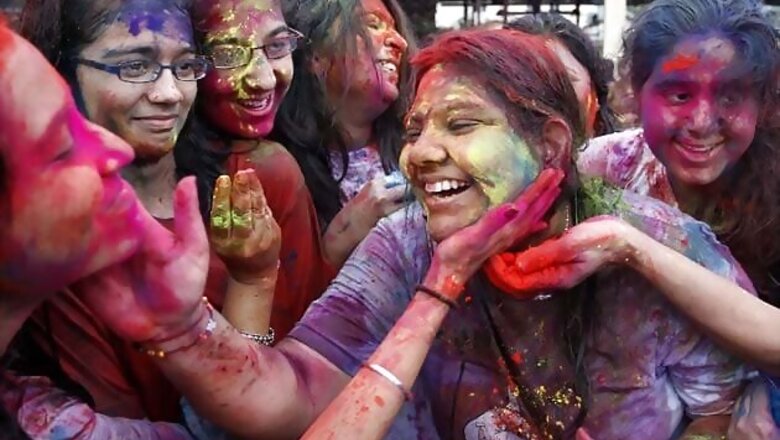
views
New Delhi: Fifteen-year-old Priyanka Sahoo - a chronic dermatitis patient - will never forget the Holi of 2012. A brief fling with artificial colours led to her undergoing surgery and keeping off any type of cosmetics and colours for the next some years.
Without knowing the difference between artificial and natural colours, Sahoo had ended up buying the former in bulk and celebrated Holi - the festival of colours - with great zeal and enthusiasm.
She could never have imagined what the bit of artificial colour could do to her skin. The teenager initially had to undergo skin surgery and was advised by her dermatologist to avoid any type of colour or cosmetics with colourants for some years.
"Soon after playing with the colours which I considered to be completely natural, my skin flared up with eczema and bumpy blisters," Sahoo told IANS.
She said that some portions of her skin were swollen and filled up with puss. Her skin would also at times start bleeding.
Sahoo has had to take a lot of medication, but her skin problem has not been completely cured.
According to medical experts, what Sahoo suffered is just a small example of what artificial colours can lead to.
Skin disorders like discoloration, contract dermatitis, abrasion, swelling of skin with puss formation, itching, and bleeding of skin can take place if the chemical content in the colours are high.
Experts also said that hair fall and partial blindness are some of the other problems caused by artificial colours.
Recent studies have concluded that among the artificial colours, green comes from a chemical known as copper sulphate, purple from chromium iodide, silver from aluminum bromide and black from lead oxide. Shiny colours are the result of powdered glass being added to them.
"Colours used during Holi were originally derived from nature but these days, synthetic dyes that have toxic effects are more in vogue, especially among the young generation. This has led to an increasing number of skin-related problems after the festival," Nitin S. Walia, senior consultant, dermatology, at the capital's B.L.K. Super Specialty Hospital told IANS.
Walia insisted that a lot of colours in the market contain mica, which makes them shiny and rough and which damages the skin, the hair and the eyes.
"The toxins used in the colours can result in a range of conditions, including skin allergies, rashes and irritation. Instead, people should try colours made of flowers and natural ingredients available at home," he added.
Health experts also suggested that people with a history of eczema or thyroid disease run a greater risk as they more readily develop allergic contact dermatitis, which manifests itself with itching, rashes and swelling.
A report by the World Health Organisation (WHO) in 2014 stated that the artificial colours that are used are highly structured polymers and are next to impossible to biologically decompose.
The study was conducted after hundreds of people suffered skin and eye complication in rural parts of India post Holi in 2013.
The experts have suggested applying any kind of oil like mustard oil, coconut oil, olive oil or vaseline over the entire body a night before and also in the morning so that its easier to remove the colours post-Holi.
Facials before the festival or immediately afterward is also not advisable as this can lead to removal of the protective layer in the first case and abrasions from the colors in the second case.
Satish Koul, general physician at Gurgaon-based Columbia Asia Hospital, said that colors, both 'gulaal' and colour-mixer fluids, should only be of credible brands that are safe on both the skin and the eyes.
"Some people use substances like grease, polish and even toilet cleaners for the wild fun but all of these elements are strictly not advisable. They might contain acids and chemicals that are likely to leave skin damaged and worse, burnt, or leave permanent scars," Koul told IANS.
Cautioning against purple and dark green colours, Koul said that they naturally contain acids and alkalis which may cause abrasions on the corneas, resulting in burns and irritation.
"Use of contact lenses should also be restricted as they can increase eye irritation, hence escalating the damage".
Ranjan Upadhyaya, dermatologist at Delhi-based Desmoderm Skin Clinic, urged the people to apply dollops of cream on the face, neck and eyes before playing with colours as these areas come under the maximum contact with colour and the lubrication provided by cream will help in easily getting rid of the colour.
Talking of the Dos and Don'ts post Holi, Anil K. Agarwal, head dermatologist at Gurgaon-based Paras Hospitals, said people should not scrub the colour off with soap immediately after playing Holi and use mosturising creams.



















Comments
0 comment